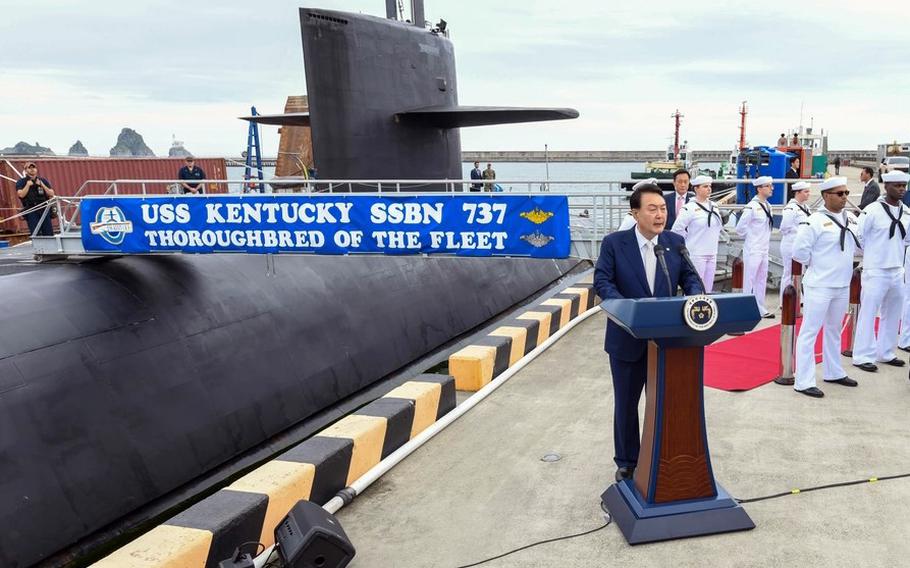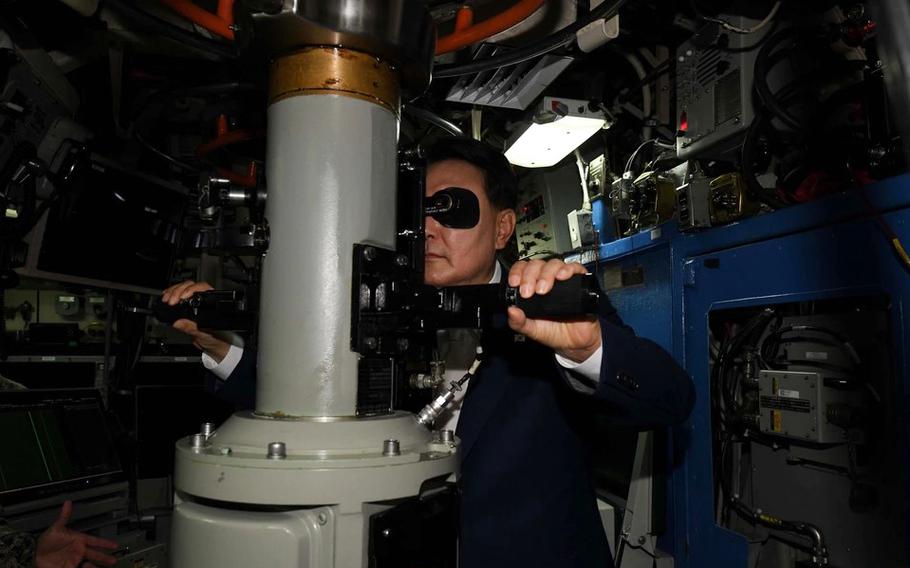
South Korean President Yoon Suk Yeol speaks during a visit to the ballistic missile submarine USS Kentucky at Naval Fleet Headquarters in Busan, South Korea, Wednesday, July 19, 2023. (Michael Chen/U.S. Navy)
South Korea’s leader boarded a nuclear-capable U.S. ballistic missile submarine this week to warn that a nuclear attack by North Korea “would lead to the end of the regime.”
The USS Kentucky, an Ohio-class submarine, the largest subs ever built for the U.S. Navy, arrived Tuesday at South Korea’s Naval Fleet Headquarters in Busan, the country’s largest port.
President Yoon Suk Yeol, standing in front of the Kentucky on Wednesday with U.S. sailors, said Washington and Seoul would continue to “enhance the visibility of U.S. strategic assets deployment” in and around the Korean Peninsula.
“This deployment of [the Kentucky] shows the willingness of South Korea and the U.S. to regularly deploy strategic assets and defend their ability to implement extended deterrence,” he said.
The submarine’s arrival “makes clear … that if North Korea provokes, it would lead to the end of the regime,” Yoon said.
“South Korea and the U.S. will continue to respond overwhelmingly and resolutely to North Korea's advancing nuclear and missile threats through regular deployment of strategic assets,” he said.
The Kentucky, commissioned in 1991 and homeported at Naval Submarine Base Bangor, Wash., can carry 20 nuclear-tipped Trident II D-5 ballistic missiles that have a range of 4,000 miles, according to the Navy’s website.
Citing the Navy’s longstanding policy of not disclosing whether nuclear weapons are aboard vessels, U.S. Naval Forces Korea spokesman Lt. Jacob Treat declined to comment on the matter by phone Thursday.

South Korean President Yoon Suk Yeol looks through the periscope of the ballistic missile submarine USS Kentucky at Naval Fleet Headquarters in Busan, South Korea, Wednesday, July 19, 2023. (Michael Chen/U.S. Navy)
The USS Robert E. Lee in 1981 was the last American ballistic missile submarine to make a port call in South Korea. It was decommissioned two years later.
Early Wednesday, hours before Yoon’s speech, North Korea fired two short-range ballistic missiles from Pyongyang that flew roughly 340 miles before splashing down in the Sea of Japan, or the East Sea, according to South Korea’s Joint Chiefs of Staff.
The launches happened one week after North Korea fired a solid-fueled Hwasong-18 intercontinental ballistic missile. The communist regime has launched 17 ballistic missiles in 12 separate days of testing so far this year.
Envoys from Washington, Seoul and Tokyo met in Japan on Thursday to discuss North Korea’s latest round of missile tests.
North Korean leader Kim Jong Un has failed to “gain respect” from his nuclear threats and has reached a “dead end,” said Kim Gunn, South Korean special representative for Korean Peninsula peace and security affairs, according to a readout of his meeting statement from the Ministry of Foreign Affairs.
The U.S. and South Korean Nuclear Consultative Group convened Tuesday in Seoul to plan on boosting the allies’ nuclear deterrent against North Korea.
“We understand the challenges here and how important it is to send a signal of commitment and confidence,” National Security Council Indo-Pacific Affairs coordinator Kurt Campbell said at a press conference Tuesday. “It is the nature of the strength of our alliance and partnership with South Korea.”